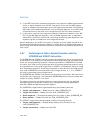
Vol. 3 5-27
PROTECTION
3. Checks the stack-segment descriptor for the proper privileges and type and
generates an invalid TSS (#TS) exception if violations are detected.
4. Temporarily saves the current values of the SS and ESP registers.
5. Loads the segment selector and stack pointer for the new stack in the SS and ESP
registers.
6. Pushes the temporarily saved values for the SS and ESP registers (for the calling
procedure) onto the new stack (see
Figure 5-13).
7. Copies the number of parameter specified in the parameter count field of the call
gate from the calling procedure’s stack to the new stack. If the count is 0, no
parameters are copied.
8. Pushes the return instruction pointer (the current contents of the CS and EIP
registers) onto the new stack.
9. Loads the segment selector for the new code segment and the new instruction
pointer from the call gate into the CS and EIP registers, respectively, and begins
execution of the called procedure.
See the description of the CALL instruction in Chapter 3, Instruction Set Reference, in
the IA-32 Intel Architecture Software Developer’s Manual, Volume 2, for a detailed
description of the privilege level checks and other protection checks that the
processor performs on a far call through a call gate.
The parameter count field in a call gate specifies the number of data items (up to 31)
that the processor should copy from the calling procedure’s stack to the stack of the
called procedure. If more than 31 data items need to be passed to the called proce
-
Figure 5-13. Stack Switching During an Interprivilege-Level Call
Parameter 1
Parameter 2
Parameter 3
Calling SS
Calling ESP
Parameter 1
Parameter 2
Parameter 3
Calling CS
Calling EIP
Called Procedure’s Stack
ESP
ESP
Calling Procedure’s Stack


















